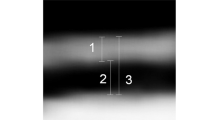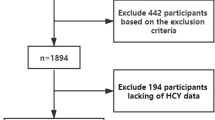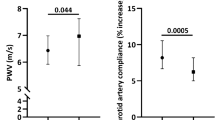Abstract
Elevated plasma homocysteine (tHcy) is considered as a risk factor for cardiovascular events, and has been associated with arterial stiffness and subclinical atherosclerosis in subjects with classical cardiovascular risk factors. The aim of this study is to investigate the association of plasma tHcy with functional and structural changes in the large arteries by measuring aortic pulse-wave velocity (PWV) and carotid artery intima-media thickness (CIMT). In a population-based sample of 376 middle-aged and elderly men, tHcy levels were measured by using fluorescence polarization immunoassay. Aortic stiffness was assessed non-invasively by measuring carotid-femoral PWV with the use of applanation tonometry. CIMT was measured by ultrasonography. We used multivariate linear regression analysis with the log-transformed value of tHcy as the determinant, and aortic PWV and CIMT as outcomes. In the univariate model, PWV increased with increasing tHcy concentration; PWV increased by 2.64 m/s (95% confidence interval (CI) 1.74; 3.54) per unit change in log tHcy. After adjustment for confounders, no statistically significant association remained; PWV increased by 0.42 m/s (95% CI −0.27; 1.11) per unit change in log tHcy. Furthermore, in the univariate model, CIMT increased significantly with increasing tHcy concentration; CIMT increased by 0.19 mm (95% CI 0.11; 0.26) per unit increase log tHcy. This association was attenuated and did not remain significant after additional adjustment for age and cardiovascular confounders (β=0.06 (95% CI −0.01; 0.13)). The results of this study do not support the presence of an independent relationship between circulating tHcy levels and large artery stiffness and thickness.
This is a preview of subscription content, access via your institution
Access options
Subscribe to this journal
Receive 12 digital issues and online access to articles
$119.00 per year
only $9.92 per issue
Buy this article
- Purchase on SpringerLink
- Instant access to full article PDF
Prices may be subject to local taxes which are calculated during checkout

Similar content being viewed by others
References
Matsuoka O, Otsuka K, Murakami S, Hotta N, Yamanaka G, Kubo Y et al. Arterial stiffness independently predicts cardiovascular events in an elderly community – longitudinal investigation for the longevity and aging in Hokkaido county (LILAC) study. Biomed Pharmacother 2005; 59: S40–S44.
Boutouyrie P, Tropeano AI, Asmar R, Gautier I, Benetos A, Lacolley P et al. Aortic stiffness is an independent predictor of primary coronary events in hypertensive patients: a longitudinal study. Hypertension 2002; 39: 10–15.
Chambless LE, Heiss G, Folsom AR, Rosamond W, Szklo M, Sharrett AR et al. Association of coronary heart disease incidence with carotid arterial wall thickness and major risk factors: the atherosclerosis risk in communities (ARIC) Study, 1987–1993. Am J Epidemiol 1997; 146: 483–494.
Lorenz MW, Markus HS, Bots ML, Rosvall M, Sitzer M . Prediction of clinical cardiovascular events with carotid intima-media thickness: a systematic review and meta-analysis. Circulation 2007; 115: 459–467.
Eikelboom JW, Lonn E, Genest Jr Jacques, Hankey G, Yusuf S . Homocyst(e)ine and cardiovascular disease: a critical review of the epidemiologic evidence. Ann Intern Med 1999; 131: 363–375.
Wald DS, Law M, Morris JK . Homocysteine and cardiovascular disease: evidence on causality from a meta-analysis. BMJ 2002; 325: 1202–1206.
Toole JF, Malinow MR, Chambless LE, Spence JD, Pettigrew LC, Howard VJ et al. Lowering homocysteine in patients with ischemic stroke to prevent recurrent stroke, myocardial infarction, and death: the vitamin intervention for stroke prevention (VISP) Randomized Controlled Trial. JAMA 2004; 291: 565–575.
Bonaa KH, Njolstad I, Ueland PM, Schirmer H, Tverdal A, Steigen T et al. Homocysteine lowering and cardiovascular events after acute myocardial infarction. N Engl J Med 2006; 354: 1578–1588.
The heart outcomes prevention evaluation I. Homocysteine lowering with folic acid and B vitamins in vascular disease. N Engl J Med 2006; 354: 1567–1577.
Woo KS, Chook P, Lolin YI, Cheung ASP, Chan LT, Sun YY et al. Hyperhomocystinemia is a risk factor for arterial endothelial dysfunction in humans. Circulation 1997; 96: 2542–2544.
Lambert J, van den Berg M, Steyn M, Rauwerda JA, Donker AJM, Stehouwer CDA . Familial hyperhomocysteinaemia and endothelium-dependent vasodilatation and arterial distensibility of large arteries. Cardiovasc Res 1999; 42: 743–751.
de Bree A, Mennen LI, Zureik M, Ducros V, Guilland J-C, Nicolas J-P et al. Homocysteine is not associated with arterial thickness and stiffness in healthy middle-aged French volunteers. Int J Cardiol 2006; 113: 332–340.
Mayer O, Filipovsky J, Dolejsova M, Cifkova R, Simon J, Bolek L . Mild hyperhomocysteinaemia is associated with increased aortic stiffness in general population. J Hum Hypertens 2006; 20: 267–271.
Woodside JV, McMahon R, Gallagher AM, Cran GW, Boreham CA, Murray LJ et al. Total homocysteine is not a determinant of arterial pulse wave velocity in young healthy adults. Atherosclerosis 2004; 177: 337–344.
Bots ML, Launer LJ, Lindemans J, Hofman A, Grobbee DE . Homocysteine, atherosclerosis and prevalent cardiovascular disease in the elderly: The Rotterdam Study. J Intern Med 1997; 242: 339–347.
Voutilainen S, Alfthan G, Nyyssonen K, Salonen R, Salonen JT . Association between elevated plasma total homocysteine and increased common carotid artery wall thickness. Ann Med 1998; 30: 300–306.
Selhub J, Jacques PF, Bostom AG, D'Agostino RB, Wilson PWF, Belanger AJ et al. Association between plasma homocysteine concentrations and extracranial carotid-artery stenosis. N Engl J Med 1995; 332: 286–291.
Kelemen LE, Anand SS, Hegele RA, Stampfer MJ, Rosner B, Willett WC et al. Associations of plasma homocysteine and the methylenetetrahydrofolate reductase C677T polymorphism with carotid intima media thickness among South Asian, Chinese and European Canadians. Atherosclerosis 2004; 176: 361–370.
Linnebank M, Moskau S, Farmand S, Fliessbach K, Kolsch H, Bos M et al. Homocysteine and carotid intima-media thickness in a German population: lack of clinical relevance. Stroke 2006; 37: 2840–2842.
Durga J, Bots M, Schouten E, Grobbee DE, Kok F, Verhoef P . Homocysteine not associated with intima media thickness. J Inherit Metab Dis 2003; 26: 25.
Gale CR, Ashurst H, Phillips NJ, Moat SJ, Bonham JR, Martyn CN . Renal function, plasma homocysteine and carotid atherosclerosis in elderly people. Atherosclerosis 2001; 154: 141–146.
Kanters SDJM, Algra A, van Leeuwen MS, Banga J-D . Reproducibility of in vivo carotid intima-media thickness measurements: a review. Stroke 1997; 28: 665–671.
Salvi P, Lio G, Labat C, Ricci E, Pannier B, Benetos A . Validation of a new non-invasive portable tonometer for determining arterial pressure wave and pulse wave velocity: the PulsePen device. J Hypertens 2004; 22: 2285–2293.
Lebrun CE, van der Schouw YT, Bak AA, de Jong FH, Pols HA, Grobbee DE et al. Arterial stiffness in postmenopausal women: determinants of pulse wave velocity. J Hypertens 2002; 20: 2165–2172.
Bots ML, Breslau PJ, Briet E, de Bruyn AM, van Vliet HH, van den Ouweland FA et al. Cardiovascular determinants of carotid artery disease. The Rotterdam Elderly Study. Hypertension 1992; 19: 717–720.
Mourad J-J, Pannier B, Blacher J, Rudnichi A, Benetos A, London GM et al. Creatinine clearance, pulse wave velocity, carotid compliance and essential hypertension. Kidney Int 2001; 59: 1834–1841.
Bortolotto LA, Safar ME, Billaud E, Lacroix C, Asmar R, London GM et al. Plasma homocysteine, aortic stiffness, and renal function in hypertensive patients. Hypertension 1999; 34: 837–842.
Glasser S . On arterial physiology, pathophysiology of vascular compliance, and cardiovascular disease. Heart Dis 2000; 2: 375–379.
Nestel PJ, Chronopoulos A, Cehun M . Arterial stiffness is rapidly induced by raising the plasma homocysteine concentration with methionine. Atherosclerosis 2003; 171: 83–86.
Davis KR, Pearson H, Moat S, Bonham JR, Donnelly R . Acute hyperhomocysteinaemia affects pulse pressure but not microvascular vasodilator function. Br J Clin Pharmacol 2001; 52: 327–332.
Wilkinson IB, Megson IL, MacCallum T, Rooijmans DF, Johnson SM, Boyd JL et al. Acute methionine loading does not alter arterial stiffness in humans. J Cardiovasc Pharmacol 2001; 37: 1–5.
Durga J, Verhoef P, Bots ML, Schouten E . Homocysteine and carotid intima-media thickness: a critical appraisal of the evidence. Atherosclerosis 2004; 176: 1–19.
Tsai MY, Arnett DK, Eckfeldt JH, Williams RR, Ellison RC . Plasma homocysteine and its association with carotid intimal-medial wall thickness and prevalent coronary heart disease: NHLBI Family Heart Study. Atherosclerosis 2000; 151: 519–524.
Willinek WA, Ludwig M, Lennarz M, Holler T, Stumpe KO . High-normal serum homocysteine concentrations are associated with an increased risk of early atherosclerotic carotid artery wall lesions in healthy subjects. J Hypertens 2000; 18: 425–430.
Adachi H, Hirai Y, Fujiura Y, Matsuoka H, Satoh A, Imaizumi T . Plasma homocysteine levels and atherosclerosis in Japan: epidemiological study by use of carotid ultrasonography. Stroke 2002; 33: 2177–2181.
Demuth K, Drunat S, Girerd X, Moatti N, Paul JL, Safar M et al. Homocysteine is the only plasma thiol associated with carotid artery remodeling. Atherosclerosis 2002; 165: 167–174.
van Guldener C, Lambert J, ter Wee PM, Donker AJ, Stehouwer CD . Carotid artery stiffness in patients with end-stage renal disease: no effect of long-term homocysteine-lowering therapy. Clin Nephrol 2000; 53: 33–41.
van Dijk RAJM, Rauwerda JA, Steyn M, Twisk JWR, Stehouwer CDA . Long-term homocysteine-lowering treatment with folic acid plus pyridoxine is associated with decreased blood pressure but not with improved brachial artery endothelium-dependent vasodilation or carotid artery stiffness: a 2-year, randomized, placebo-controlled trial. Arterioscler Thromb Vasc Biol 2001; 21: 2072–2079.
Williams C, Kingwell BA, Burke K, McPherson J, Dart AM . Folic acid supplementation for 3 wk reduces pulse pressure and large artery stiffness independent of MTHFR genotype. Am J Clin Nutr 2005; 82: 26–31.
Durga J, Bots ML, Schouten EG, Kok FJ, Verhoef P . Low concentrations of folate, not hyperhomocysteinemia, are associated with carotid intima-media thickness. Atherosclerosis 2005; 179: 285–292.
Marcucci R, Zanazzi M, Bertoni E, Rosati A, Fedi S, Lenti M et al. Vitamin supplementation reduces the progression of atherosclerosis in hyperhomocysteinemic renal-transplant recipients. Transplant Proc 2003; 75: 1551–1555.
Till U, Rohl P, Jentsch A, Till H, Muller A, Bellstedt K et al. Decrease of carotid intima-media thickness in patients at risk to cerebral ischemia after supplementation with folic acid, vitamins B6 and B12. Atherosclerosis 2005; 181: 131–135.
Author information
Authors and Affiliations
Corresponding author
Rights and permissions
About this article
Cite this article
Nakhai-Pour, H., Grobbee, D., Bots, M. et al. Circulating homocysteine and large arterial stiffness and thickness in a population-based sample of middle-aged and elderly men. J Hum Hypertens 21, 942–948 (2007). https://doi.org/10.1038/sj.jhh.1002247
Received:
Revised:
Accepted:
Published:
Issue date:
DOI: https://doi.org/10.1038/sj.jhh.1002247
Keywords
This article is cited by
-
Blood Homocysteine Levels Mediate the Association Between Blood Lead Levels and Cardiovascular Mortality
Cardiovascular Toxicology (2024)
-
Associations between plasma homocysteine levels, aortic stiffness and wave reflection in patients with arterial hypertension, isolated office hypertension and normotensive controls
Journal of Human Hypertension (2010)
-
Pulse Pressure Amplification and Risk of Cardiovascular Disease
American Journal of Hypertension (2008)
-
Arterial stiffness: beyond pulse wave velocity and its measurement
Journal of Human Hypertension (2008)



